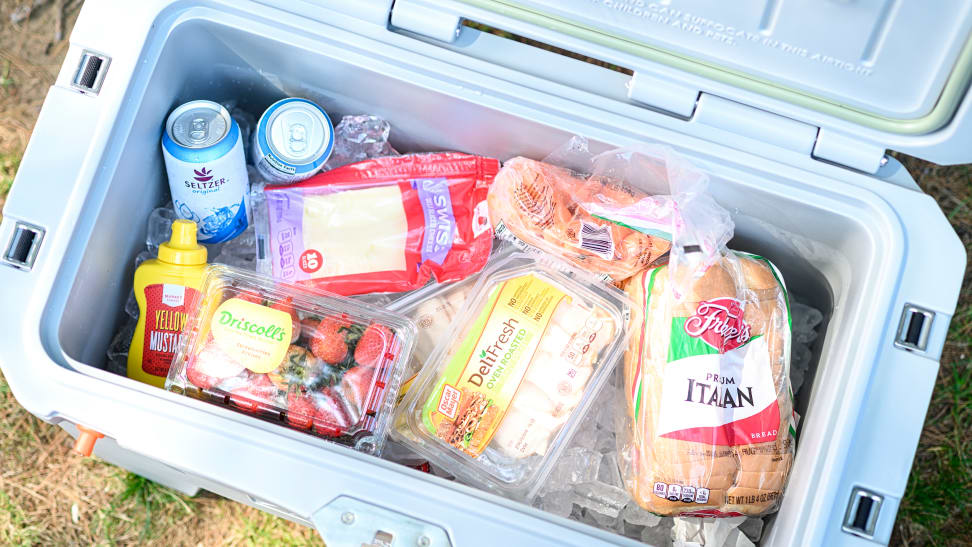 — Recommendations are independently chosen by Reviewed’s editors. Purchases you make through our links may earn us a commission.
— Recommendations are independently chosen by Reviewed’s editors. Purchases you make through our links may earn us a commission.We're updating this article to include the Yeti V series and Pelican Elite. We're always testing new coolers, so stay tuned for further updates!
When you’re unwinding outdoors, the right cooler makes all the difference. Imagine going on a deep-sea fishing trip for a few days, only to find your entire catch has spoiled. Or reaching for a cold one after a game of touch football only to find your drinks are warm. You have a limited amount of leisure time, don’t let a bad cooler ruin it.
A good cooler is more than just an insulated plastic box that can keep your ice frozen. What you need depends on the activity. For example, a fisherman would want a ruler on the lid of his cooler to make sure his catch is legal, but a bowhunter would want a model that’s bear-resistant to keep her basecamp safe. And everyone benefits from a cooler with a built-in bottle opener.
Overall, after extensive testing of the best coolers on the market in the heat of summer, our favorite was the OtterBox Venture 45 (available at Amazon for $349.99). Offering great insulation, durability, and customization, we think the OtterBox Venture 45 will best serve the needs of the average tailgater, fisher, and camper. However, if you're looking for a more affordable option, we'd suggest getting the Ozark Trailer. It might not keep food as cool as long as the OtterBox, but it has more cupholders.
If you’re curious to know about the other ice coolers we’ve tested, we have a total list of 13 that have gone through our tests to see which one can keep your food and drink cool the longest.
These are the best ice coolers we tested ranked, in order:
- Yeti V Series
- Pelican Elite
- Otterbox Venture 45
- Ozark Trail
- RTIC
- Yeti Hopper Two 30
- Yeti Tundra 45
- Everbilt
- Otterbox Trooper LT30
- Arctic Zone
- Igloo Marine Ultra
- Igloo Island Breeze
- Lifeproof
- Coleman 50 can
- Coleman 30 can
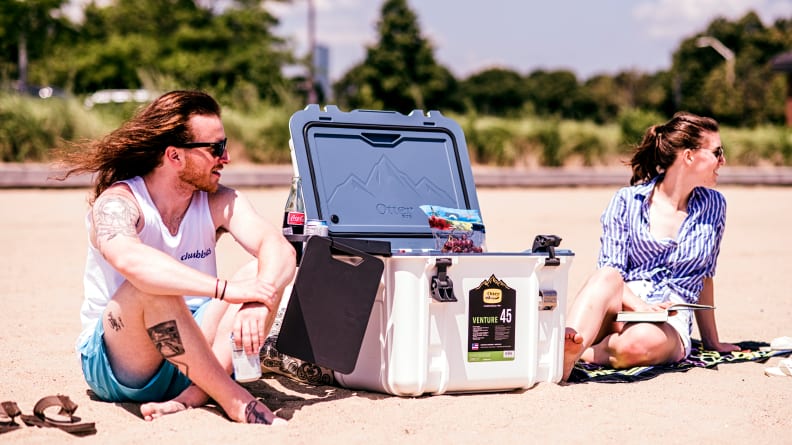

The Otterbox Venture 45 won our top spot.
Cold hard facts: 45-quart capacity; includes dry storage tray and bottle opener; bear-resistant; limited lifetime warranty.
Out of all of the ice coolers that we tested, the Otterbox Venture 45 kept its cool, and had great versatility and usability. Through our testing, it was able to keep temperatures under 40°F for almost five days, 20% above average. We found the latching lock system easy to use, and once engaged nothing leaked out no matter how much we shook the unit. In addition, we appreciated the added mounting system on the front and back for any attachments that you would like to place (eight in total). The way the handles are built into the body of the cooler made us feel confident when moving the Venture.
When you decide to set up camp, you can use the side handles to tie-down the cooler for extra security. Even without that though, we found the rubber feet to be well designed and sturdy on their own. When loaded with ice and drinks, Venture didn’t budge an inch after a swift kick from our boot, where lesser coolers tipped over. After the fun was done, we popped the drain and watched all the melted ice drain through the sloped interior.
If we had one complaint, it would be that the price is a bit high for anyone who doesn’t go on multi-day fishing or camping trips.
Pros
-
Great temperature retention
-
Versatile mounting system
-
Doesn't leak
Cons
-
Expensive
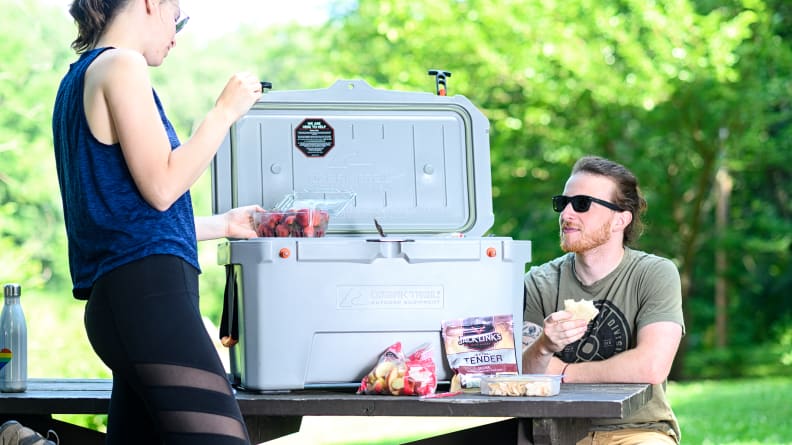

We found the Ozark Trail to have the right balance of value and performance.
Cold hard facts: 52-quart capacity, includes wire basket, bear-resistant, limited five-year warranty.
The Ozark Trail found its way to be our best value pick. It has a built-in fish ruler, four cup holders, a bottle opener, a threaded plug, and T-handles. It also comes with a removable wire basket. During our tests, the Ozark Trail stayed cool a little over four days before it hit the 40°F, the point at which the FDA says meat will spoil. Based on all its extra features, we think this cooler is perfect for anyone looking for a leisurely trip—think of all those cupholders! We really mean leisurely—this cooler lacks any built-in method for mounting it to a truck or boat.
Because it didn’t ace the temperature retention tests and can’t handle being in choppy situations, like the Venture, it did not get the top spot. However, given its low price, we think it’s a solid value.
Pros
-
Affordable
-
Has plenty of features
-
Includes a removable wire basket
Cons
-
No mounting system
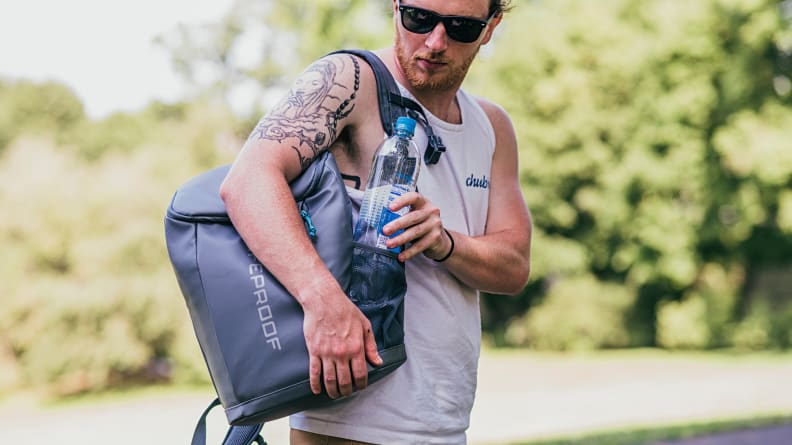
The Lifeproof backpack cooler won the top spot for the best portable cooler.
Cold hard facts: 18- to 24-can capacity; includes ice pack, bottle opener, two pockets, and water bottle holder.
At first glance, we thought the Lifeproof was just a backpack. However, after spending a week testing it, this portable cooler impressed us with its design. The flat bottom is a great design choice that allows the backpack to sit upright, allowing you to take a break from carrying it without risking a spill. The padded back and shoulder straps kept us from feeling the weight on our shoulders while we did laps around our lab. And as much as we liked the cooler, the Lifeproof did not forget that it was a backpack at heart, providing plenty of pockets for items that don’t need to be chilled.
For example, a pocket on the side provided easy access to a water bottle. There are two side straps that allow for attaching any items you want. Lastly, we appreciate the inclusion of an ice pack, because who has time to buy ice?
During our temperature tests, the Lifeproof lasted two days before it reached the 40°F mark, making it perfect for short trips. Anything beyond that, and you need to rethink your expectations of a portable cooler.
Pros
-
Sits up-right
-
Padded back and shoulder straps
-
Includes an ice pack
Cons
-
Doesn't retain temperature for long periods
How We Tested
The Testers
Hi, Kyle Hamilton, Jon Chan, and Dr. Julia MacDougall here! We’re the testing team at Reviewed, which means we designed and implemented the experiments involved in this article. For ice coolers, we were most concerned about performance, portability, and price.
The Selection Process
When searching for the right cooler or ice chest to test, we made sure to include some of the most popular units on the market. We also knew that we wanted to include a variety of coolers, ranging from hard to soft, portable to heavy-duty. In addition to types, we took care to find coolers available at a variety of retailers, including Amazon, Home Depot, and Walmart.
The Tests
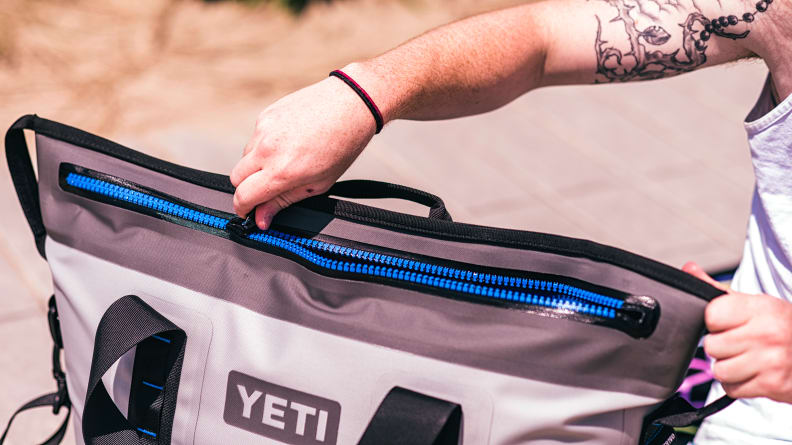
In some cases, coolers that performed well did not win top spots because they were difficult to use.
After being assigned this project, we knew the first thing we wanted to test was how long each cooler could maintain a temperature. To do this, we filled each cooler, regardless of size, halfway up with ice. We then placed the ice coolers into our humidity-controlled lab space to make sure we always had a consistent ambient temperature of 72°F and 50% relative humidity. To track the temperature of each cooler, we placed two sensors that recorded the temperature over time so we could know when the internal conditions reached over 40°F—the point at which meat becomes unsafe to eat. One sensor was placed at the bottom of the cooler, wrapped inside a ground pork meatball. We placed the other sensor on top of the ice and removed it daily both to get readings and simulate normal use. The test ended when all a cooler visibly contained no ice.
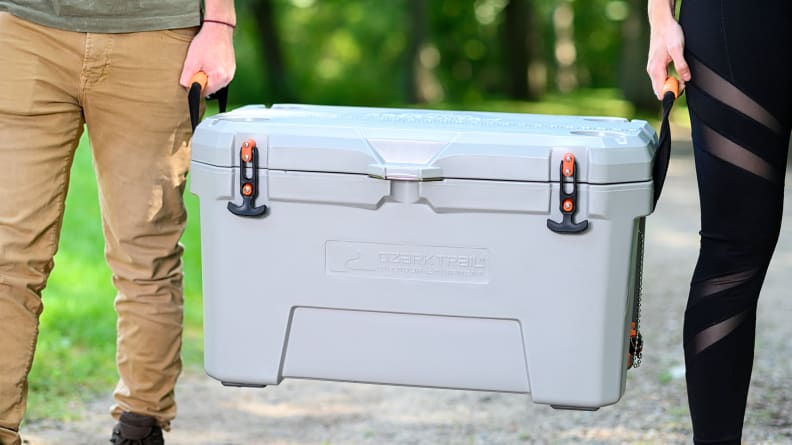
The best way to test portability is to carry a cooler around.
The next tests involved portability, build quality, and aesthetics of each ice cooler. We design the portability test to be pretty straight forward: Fill the cooler with water and walk around with it. We went up inclines, took sharp turns, and trotted around the lab. Exhausted and out of breath, we then tested to see if they were leakproof by tipping each cooler to see if the water would come out. Emptying each model of water gave us a chance to look into the design and features. Lastly, we filled each cooler up with soda cans to see how many cans you could fit into them and compare it to the claimed capacity of the ice coolers.
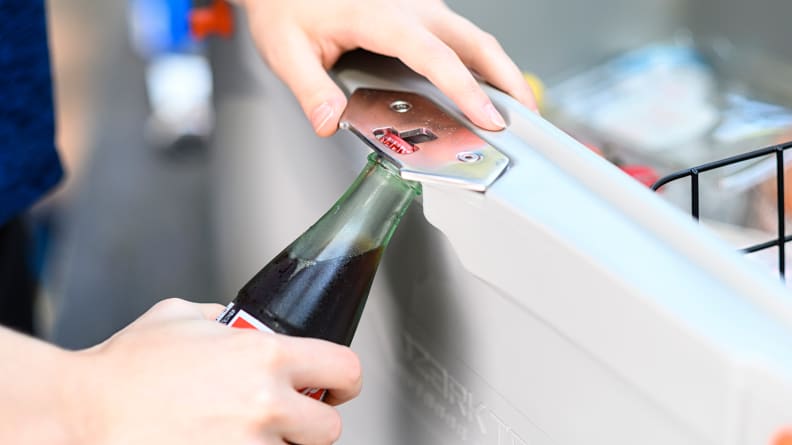
Nowadays, coolers are more than just plastic boxes. We tested all the extra features to see if they worked.
What You Should Know About Coolers
How Much Ice Should I Use?
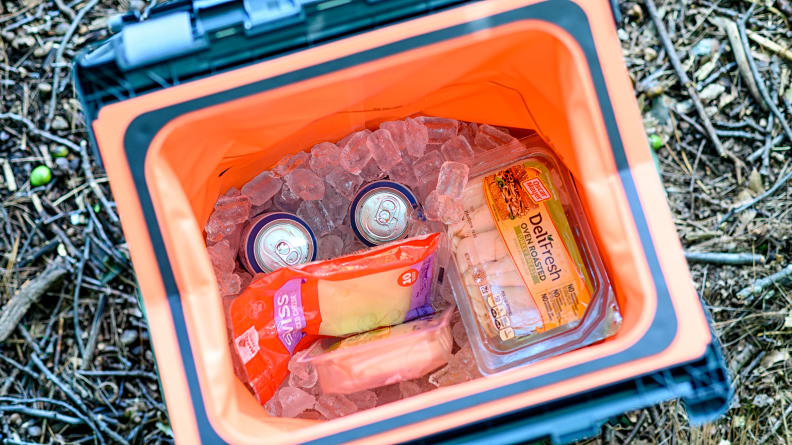
You should use a 2-to-1 ice-to-food ratio.
According to Popular Mechanics, you should use a 2-to-1 ratio of ice to items being cooled. For example, if you were cooling a gallon jug of milk, you’d use two gallons of ice to keep it cool. However, the more ice the better the food preservation.
How Can I Make My Cooler Last Longer?
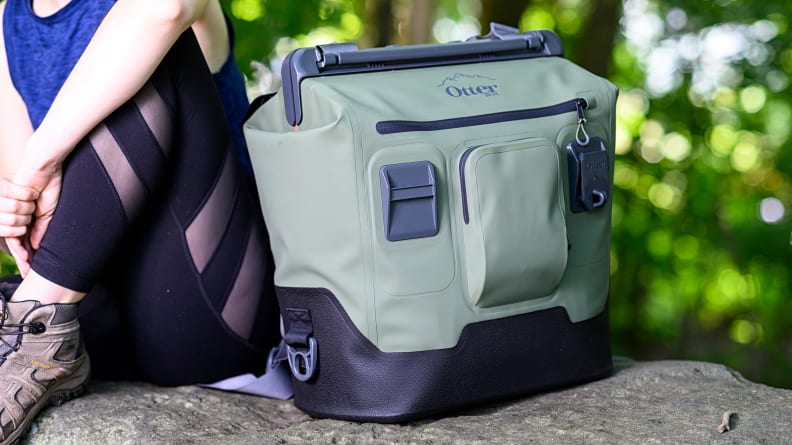
To maximize your cooler's performance, keep it locked up tight and in the shade.
• Pre-cool your cooler: If you’re storing your cooler in a hot garage, bring it inside so it can get up to room temperature, that way you’re not wasting energy cooling down a hot plastic box.
• Avoid using ice that's already melting: A bag of ice that's dripping water is already too warm to keep a cooler at the correct temperature
• Don't drain out the excess water: Cold water helps insulate the ice you add in.
Can I Use Dry Ice in a Cooler?
Dry ice can be used in most coolers. It’s way colder than normal ice and can keep ice cream and meat frozen. When it evaporates, it leaves no puddles to clean up. There are some disadvantages. Dry ice melts at an alarming rate, about 5-10 pounds every hour depending on how often you open the cooler. It also someone dangerous to store indoors, as it is constantly outputting carbon dioxide.
Are Coolers With Wheels Worth It?
You may have noticed that none of the coolers we tested have wheels. After doing some extensive research, we decided not to include any rolling coolers. The milage people get out of wheeled coolers varied too much for our liking. On the lower end of the price spectrum, wheels and axles are a major point of failure, one of the first things to go on a cooler. Premium coolers with sturdy wheels and long warranties can go for over $400, a little too rich for our blood.
However, if you’re dead set on getting a cooler with wheels, we’d suggest thinking of your cooler like a piece of luggage rather than an icebox. Look for a unit that has a comfortable handle that can extend comfortably to your height. For the wheel themselves, the bigger the better. Bigger wheels spread out the wear and make for a smoother experience.
What Should You Look for in a Cooler for Camping?
It all comes down to how long and how far you’re going out. For trips that are less than a day, a portable backpack cooler is perfect. Just keep in mind that backpack coolers work better with ice packs than loose cubes. Once that ice melts, the sloshing will make the backpack more unstable.
If you’re heading into the backcountry, you’re going to need something more robust. The coolers that keep hot air out the best typically have T-handles and are difficult to open because of how well they seal shut. Not only do you want a unit that’s well-insulated, but you also want one that keeps the scent of your supplies away from bears and other predators.
When packing a cooler to preserve food for more than a day, you should use a combination of chunks and chips of ice. Chips help with immediate cooling and chunks are for the long haul. Also, be sure to store your cooler in the shade away from direct sunlight.
Other Coolers We Tested

Cold hard facts: 46-can capacity (with ice), 56-can capacity (without ice), stainless steel exterior, weighs 35 pounds, three-year warranty
The Yeti V series cooler is in a league of its own. Over the course of testing, the internal temperature never went above 37°F, for eight days. It performed so well, we actually had to redo the scaling of testing after this cooler. The stainless steel latch loop and vacuum insulated panels really did their job to a degree we did not expect.
However, even with all this fancy technology, we can’t give this cooler an award. First, the V series is in its own price bracket. It’s almost triple the price of its nearest competitor. We also thought the exterior was way too shiny, almost obnoxiously so if you went to the beach. And while this cooler contains some impressive technology, it’s overkill for barbeques, tailgating, and beachgoing.
Pros
-
Stainless steel exterior
-
Superior temperature retention
Cons
-
Very expensive

Cold hard facts: 50-quart capacity, built-in fish ruler, built-in bottle opener, built-in cup holders, lifetime warranty
The Pelican Elite is a top-tier cooler. Our testing showed that it could keep meat and drinks cold for up to five days. Combine the high insulation with the huge interior, and you can easily carry enough food for two people for a long weekend.
During testing, our reviewers found it a bit cumbersome and bulky to carry around. We’d suggest this for road trips rather than backcountry camping. Overall we found the Elite easy to maintain. It has a threaded stopper at the bottom to drain ice melt and it has durable stainless steel parts for durability.
Given the high price, this cooler is an investment. If the open road is constantly calling out to you, you should check this model out.
Pros
-
Good temperature retention
-
Feature filled
-
Lifetime warranty
Cons
-
Expensive
-
Bulky

Cold hard facts: 45-quart capacity, includes no-slip feet and multiple drains, limited lifetime warranty.
In our testing, the RTIC cooler lasted a little over four days before it hit the 40°F. The RTIC comes equipped with tie-down slots, anti-slip rubber feet, rope handles with comfort grips, and T-handle latches. A nice perk of this cooler is that it has two drains, making it much easier and faster to drain. Unlike other T-handle latches in this roundup, we did not find the ones on the RTIC to be a pain to open.
Pros
-
Good temperature retention
-
Anti-slip rubber feet
-
Has two drains
Cons
-
Expensive

Cold hard facts: 23-can capacity; includes six tie-down points, three reinforced handles, a leak-proof zipper; three-year warranty.
Out of the many soft ice coolers that we tested, the Yeti Hopper Two 30 was the only cooler with a water- and leak-proof zipper. The Hydrolok zipper is durable and has a built-in seal in-between, making sure the cold air stays in for long periods of time. Although, due to the sturdy nature of the zipper, it is a little tough to open at times, but it’s definitely worth it for that good seal. It also has closed-cell foam insulation: a superior form of insulation compared to most soft coolers.
With its design of both zipper and insulation, this Yeti cooler was able to keep in ice for three days and 12 hours, impressive for a soft cooler. Besides its design on the inside, it has good added value features on the outside. All the handles are double-stitched which allows for easy carry for all loads. It has tie-down points on the sides, making it mountable. It also has multiple hitch points on the front and back of the cooler, allowing you to add any attachments you might want to bring along. Included also is a shoulder strap for easier carrying. Lastly, the bottom base is nice and flat, keeping the cooler upright at all times and adding that extra bit of sturdiness.
Pros
-
Excellent water and leak proof zipper
-
Good insulation compared to other soft-coolers
-
Multiple tie-down points
Cons
-
Expensive

Cold hard facts: 45-quart capacity, includes dry-goods basket and anchor point tie-down slots, five-year warranty.
During our testing, the Yeti Tundra 45 was able to last four days until the temperature reached 40°F. The T-handle latches are nice to use and aren’t too stiff. The drain works well, although it does not have a latch to stay onto the cooler. The rope handles are okay, the grips are sturdy and the length is a decent size. The non-slip feet work well and keep the cooler in place, as do the tie-down slots on the sides. The top of the lid is textured, which can be used for multiple purposes, including as a chair that won’t slide around. The included wire basket is a nice addition to hold any additional items that don’t need to be touching ice.
Pros
-
Good temperature retention
-
Includes a dry-goods basket
Cons
-
Expensive

Cold hard facts: 52-quart capacity; includes built-in fish ruler, two cup holders, and bottle opener; UV-resistant; five-year warranty
Everbilt High Performance lived up to its name, keeping ice cool longer than any other in our roundup. It lasted almost six days before the internal temperature reached 40°F. The results impressed us even more because this cooler is half the price of many of its competitors. Besides the nice insulation, the Everbilt also comes plenty of crowd-pleasers like a fish ruler, cup holders, and a bottle opener.
When we finished the performance and portability tests, draining the Everbilt was a cinch. This cooler has a massive drain that has threads for a small hose. A chain keeps the drain cap from getting lost, a major plus when on the water or after a season of storage.
With excellent performance scores, we thought the Everbilt was going to claim a top spot. Then we did the portability testing. The Everbilt uses rope handles. Even though it has comfort grips, we found the ropes too long, making it extremely awkward to lug around. It does have pocket handles as an alternative, but it’s a tight squeeze for any adult hand. Also, speaking of being an adult, multiple grown men had trouble opening this cooler. While the T-handles provide a great seal, imagine waking up early in the morning—groggy and starving—to be bested by a cooler.
Pros
-
Great seal for good insulation
-
Includes many features
-
UV-resistant
Cons
-
T-handles are hard to open
-
Awkward to lift

Cold hard facts: 30-quart capacity; includes a food-grade liner, waterproof external pockets, and bottle opener; limited lifetime warranty.
If there was ever an ice cooler, especially a soft-body cooler, to be described at heavy-duty, it would have to be the Otterbox Trooper LT 30. This massive ice “briefcase” is designed for short jaunts into rough terrain. In our tests, it was able to keep the temperature below 40°F for just over three days. The wide-mouth opening is an awesome design, making it easy to open and access.
It also has a great seal that is leakproof, so everything says inside. The handles are very durable and wide, making it easier to carry. As for wearing it as a backpack, it can be a bit awkward to walk around with, especially if it’s full of ice and beverages. However, the padded back and backpack straps help out a lot, making it more tolerable. The two front-facing pockets are a nice addition and it’s great that they too are waterproof. Also, on the front are two mounting brackets for accessories. Lastly, the base is very sturdy, keeping the ice cooler upright and protecting from abrasion.
Pros
-
Good seal
-
Wide-mouth opening design
-
Durable exterior
Cons
-
Expensive
-
Bulky

Cold hard facts: 30-can capacity; includes a smart shelf, bottle opener, and zipperless open; limited lifetime warranty.
In our tests, the Arctic Zone Titan Freeze cooler lasted two days and 12 hours. The biggest feature to note is that this cooler doesn’t have a zipper to close the top of the lid. Instead, it’s just held by a Velcro strap, making it much easier to access and still have the ability to keep in the cold. Aside from having a lack of zippers, the Titan also offers some unique features such as the removable hard body liner and smart shelf, insulated pockets, and a bottle opener on the side. In addition to the large padded shoulder strap it comes with, it also has two handles on the side for any time you need to fully pack the cooler. The handles hide nicely inside two side pockets, which are also perfect for holding water bottles.
Pros
-
Zipperless for easier access
-
Removable hard body liner
Cons
-
No seal means less temperature retention

Cold hard facts: 48-quart capacity, includes two rules and UV inhibitors, one-year warranty.
In our tests, the Igloo Marine Ultra lasted three days and 12 hours before the temperature reached 40°F. For being a very simple ice cooler, there are some nice perks that go a long way, especially for those who want a cheap option for fishing. It has tie-down loops on the side so you can mount the cooler down. It also comes with two rulers on the top of the lid, one in Imperial and the other in metric.
The handles provide a comfortable grip and are currently our favorite out of all the box coolers that we’ve tested. They flip up to the perfect height and the comfort grips live up to their name. It does come with a drain hose, but there is no slope and the drain is higher than the base of the cooler, which can lead to sitting water unless you tip the cooler.
Pros
-
Great handles
-
Has 2 rulers on the lid
Cons
-
Poor drain leads to sitting water

Cold hard facts: 48-quart capacity, stain-resistant liner.
Even simpler than the Igloo Marine Ultra is the Igloo Island Breeze. Not offering too much, the Island Breeze is little more than a plastic box with some flip-up handles on the side. It doesn’t even come with a drain. In our tests, it was able to last a little over two days before the temperature reached 40°F. However, that’s over the advertised ice retention of one day. While this Igloo exceeded our expectations, it did not impress us.
Pros
-
Decent temperature retention
Cons
-
No drain

Cold hard facts: 50-can capacity, collapsible.
This Coleman cooler was able to keep in the cool temperature for just a little over 24 hours before the ice melted. It has two handles on the side with an adjustable shoulder strap. On the front, it has a decent-sized zipper pocket for holding items that don’t need to be cooled. Velcro straps festoon the exterior, keeping the lid closed, securing loops, and even allowing this Coleman to collapse into an easily storable mat. We should also point out that this Coleman was one of the few models that was not water-resistant.
Pros
-
Collapsible
Cons
-
Not water-resistant

Cold hard facts: 30-can capacity, includes a front pocket.
Similar to its 50-can counterpart, this Coleman cooler lasted a little over a day before it reached 40°F. It comes with two side handles and a shoulder strap. On the front, you’ll find a pocket that can fit slim items. While on the top, the biggest feature hides: A Velcro hatch, giving easy access to the cooler without having to keep opening the zipper.
Pros
-
Has a velcro hatch for easy access
-
Includes a front pocket
Cons
-
Doesn't retain temperature for long periods

